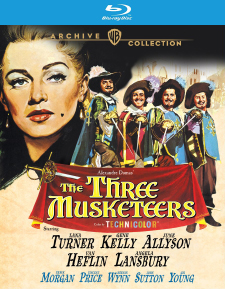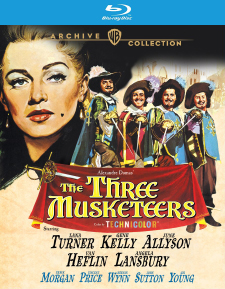Three Musketeers, The (1948) (Blu-ray Review)

Director
George SidneyRelease Date(s)
1948 (February 15, 2022)Studio(s)
MGM/Warner Bros (Warner Archive Collection)- Film/Program Grade: B
- Video Grade: A
- Audio Grade: B+
- Extras Grade: B-
Review
MGM’s 1948 production of The Three Musketeers is based on the 1844 novel by Alexandre Dumas. A silent version in 1921 had been a big hit for Douglas Fairbanks. To date, there have been over 50 film and TV adaptations of the novel, both live action and animated. The MGM version features an all-star cast, headed by Gene Kelly and Lana Turner, that balances lots of swashbuckling adventure with broad comedy.
Young swordsman D’Artagnan (Kelly) leaves his country village and sets out for Paris, where he hopes to become a musketeer. He has the bad fortune to run afoul separately of three expert musketeers, Athos (Van Heflin), Porthos (Gig Young), and Aramis (Robert Coote). As honor demands, he agrees to a duel with each of them in three successive hours. When D’Artagnan shows up for his first encounter, he sees, to his surprise, that Athos has brought Aramis and Porthos as his seconds. A group of the king’s soldiers soon show up to arrest them for dueling, strictly outlawed. The musketeers, joined by D’Artagnan, engage the soldiers in a lengthy, often comic fight featuring lightning-fast swordplay, breathtaking athleticism, and plenty of amusing touches.
D’Artagnan joins the musketeers in their efforts to protect the weak King Louis XIII (Frank Morgan) from his powerful prime minister, Richelieu (Vincent Price), who’s trying to incite a war with England. The treacherous Lady de Winter (Turner) uses her sexual wiles as Richelieu’s chief spy to achieve his nefarious goals.
Meanwhile, the musketeers’ beloved Queen Anne (Angela Lansbury) has been having secret trysts with the British ambassador, the Duke of Buckingham (John Sutton), and gives him two diamonds from a set of twelve recently given to her by the king. Richelieu sends Lady de Winter to steal the jewels from Buckingham so he can present them as evidence to the king of the queen’s infidelity. The musketeers, aided by the queen’s loyal servant Constance (June Allyson), set out for England to retrieve the diamonds.
Director George Sidney has crafted some rousing action sequences with acrobatic derring-do, lots of stunt work, and swordplay choreographed as precisely as dance numbers. Kelly combines athletic ability and graceful movement to make these scenes great fun. Tumbling, jumping, summersaulting, and bounding about, he infuses terrific energy into his performance, which ranks among his best screen appearances.
The first version of the tale to be filmed in color, The Three Musketeers is visually spectacular, with Turner’s enormous plumed hats and gowns in vibrant primary hues and the musketeers’ lavish costumes, as well as the opulent sets, geared to dazzle. The all-star cast adds stature to a story that was familiar to audiences in the late 1940s yet still filled seats in theaters.
Though Turner is billed first, Kelly has far more screen time and the story revolves around his character. Kelly, who had shown his athletic agility earlier in Living in a Big Way and The Pirate, contributes considerable humor, maintaining a balance between the basic plot and comical enhancements. Though a bit too old to play a young man just leaving home to seek his fortune, he adds charm and a mischievous twinkle to his performance, endearing him to the viewer.
Price is well cast as Richelieu, projecting an evil smile and a politician’s cunning as his character’s unctuous attentions to the king and nefarious plot threaten to create war. Allyson’s Constance serves both as a love interest for D’Artagnan and as a key player in the sub-plot involving Lady de Winter. Of the musketeers, only Van Heflin, as Athos, has a substantial role, with Porthos and Aramis practically extras in the film.
Despite its strong action quotient, the film is too long, overly reliant on a series of duels, with dull stretches of exposition that put the brakes on narrative flow. At 126 minutes, the film could easily have been trimmed by at least ten minutes. Richard Lester’s The Three Musketeers of 1973 managed to get things right in a briskly paced picture with plenty of star power and exceptionally well-tuned humor. That film allowed each of the musketeers to be developed rather than serve as colorful set dressing.
The Three Musketeers was shot by director of photography Robert H. Planck on 35 mm film with spherical lenses, finished photochemically, and presented in the aspect ratio of 1.37:1. The Blu-ray release features a transfer from a new high definition master struck from a 4K scan of the original nitrate Technicolor negative. Contrast and clarity are excellent. Technicolor has always been unsurpassed at reproducing primary hues, and this release is no exception. Lana Turner’s large, ostrich-plumed hats and elaborate gowns are in deep vibrant green, blazing red, deep purple, and lime green. Heflin’s lavender outfit is appropriately eye-catching. Details, such as patterns on the musketeers’ doublets, objects in the queen’s chamber, Athos’ facial hair and wrinkles, and Turner’s jewelry, are nicely delineated. Complexions are pleasant, though Turner and Allyson wear contemporary make-up, a must for MGM’s female stars. Turner looks especially alluring with her creamy skin, red lipstick, and blonde hair. Planck’s cinematography contributes to the comedy as he focuses on prankish moves during life-or-death duels.
The soundtrack is English 2.0 mono DTS-HD Master Audio. Dialogue is clear throughout, though for a film in which most of the cast is French, no one attempts a French accent. The dominant sound effect is the clashing and clanking of swords. Occasionally, gunshots from muskets are heard. The musical score combines original music by Herbert Stothart and the main theme from Tchaikovsky’s Romeo and Juliet (the love motif for D’Artagnan and Constance). The music beautifully enhances the swordplay scenes and offers suspense during tense moments. The score nicely contrasts the film’s high-spirited, lighter moments with its serious dramatic scenes. English SDH subtitles are an available option.
Bonus materials on the Blu-ray release from the Warner Archive Collection include:
- Looking at London (10:09)
- What Price Fleadom (6:57)
- Radio Promo (14:04)
- Theatrical Trailer (1:56)
Looking at London – In this 1946 James A. Fitzpatrick TravelTalk short, post-World War II views of England’s capital are shown, including Marble Arch, the Bank of England, Buckingham Palace, Trafalgar Square, the National Gallery, St. Paul’s Cathedral, and Piccadilly Circus. A good portion of the film shows bombed sections of the city.
What Price Fleadom – In this 1948 Tex Avery cartoon, a dog is happy to play host to a resident flea named Homer. They live a symbiotic, carefree relationship until their harmony is threatened when Homer eyes a lady flea on a passing bulldog.
Radio Promo – In this 1948 MGM radio promotion for The Three Musketeers, Lana Turner is briefly interviewed. At that point, she had made 24 films with many different leading men. Audio-only excerpts are played from Love Finds Andy Hardy (with Mickey Rooney), Calling Dr. Kildare (Lionel Barrymore), Ziegfeld Girl (James Stewart), Johnny Eager (Robert Taylor), Somewhere I’ll Find You (Clark Gable), Slightly Dangerous (Robert Young), Green Dolphin Street (Van Heflin), and Cass Timberlane (Spencer Tracy).
A major problem with The Three Musketeers is its over-abundance on dueling scenes, which become repetitive. The best one occurs early in the picture and is never topped. George Sidney’s direction strives to combine slapstick, melodrama, and epic action, yet never manages a comfortable blend. The Three Musketeers did huge business during its initial theatrical release and was obviously a crowd pleaser. MGM in its heyday was known for extravagance, and the film is a showcase of the studio’s style. Seen today, it’s a fun costume picture with an impressive roster of the studio’s contract stars.
- Dennis Seuling

